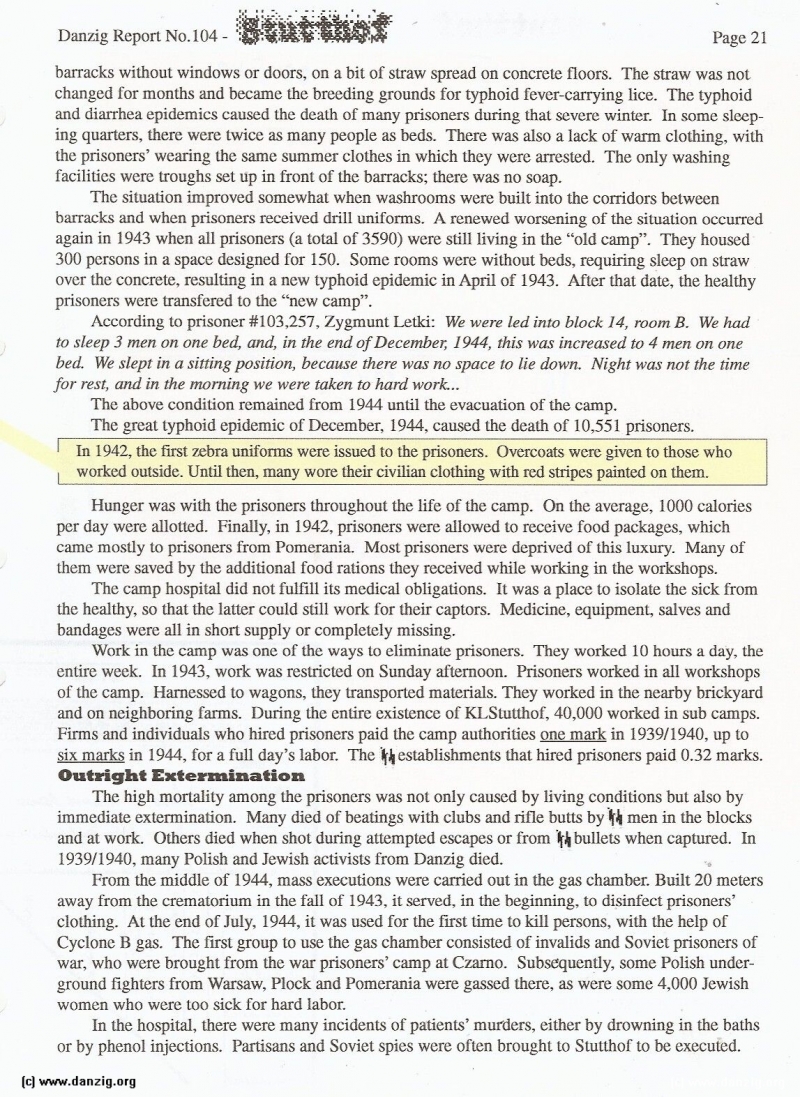
barracks without windows or doors, on a bit of straw spread on concrete floors. The straw was not changed for months and became the breeding grounds for typhoid fever-carrying lice. The typhoid and diarrhea epidemics caused the death of many prisoners during that severe winter. In some sleepi ng quarters, there were twice as many people as beds. There was also a lack of warm clothing, with the prisoners’ wearing the same summer clothes in which they were arrested. The only washing facilities were troughs set up in front of the barracks: there was no soap.
The situation improved somewhat when washrooms were built into the corridors between barracks and when prisoners received drill uniforms. A renewed worsening of the situation occurred again in 1943 when all prisoners (a total of 3590) were still living in the “old camp”. They housed 300 persons in a space designed for 150. Some rooms were without beds, requiring sleep on straw over the concrete, resulting in a new typhoid epidemic in April of 1943. After that date, the healthy prisoners were transfered to the “new camp”.
According to prisoner #103,257, Zygmunt Letki: We were led into block 14, room B. We had to sleep 3 men on one bed, and, in the end of December 1944, this was increased to 4 men on one bed. We slept in a sitting position, because there was no space to lie down. Night was not the time for rest, and in the morning we were taken to hard work..
The above condition remained from 1944 until the evacuation of the camp.
The great typhoid epidemic of December, 1944, caused the death of 10,551 prisoners.
In 1942, the first zebra uniforms were issued to the prisoners. Overcoats were given to those who worked outside. Until then, many wore their civilian clothing with red stripes painted on them.
Hunger was with the prisoners throughout the life of the camp. On the average, 1000 calories per day were allotted. Finally, in 1942, prisoners were allowed to receive food packages, which came mostly to prisoners from Pomerani& Most prisoners were deprived of this luxury. Many of them were saved by the additional food rations they received while working in the workshops.
The camp hospital did not fulfill its medical obligations. It was a place to isolate the sick from the healthy, so that the latter could still work for their captors. Medicine, equipment, salves and bandages were all in short supply or completely missing.
Work in the camp was one of the ways to eliminate prisoners. They worked 10 hours a day, the entire week. In 1943, work was restricted on Sunday afternoon. Prisoners worked in all workshops of the camp. Harnessed to wagons, they transported materials. They worked in the nearby brickyard and on neighboring farms. During the entire existence of KLStutthof, 40,000 worked in sub camps. Firms and individuals who hired prisoners paid the camp authorities one mark in 1939/1940, up to six marks in 1944, for a full day’s labor. The V establishments that hired prisoners paid 0.32 marks.
Outright Extermination
The high mortality among the prisoners was not only caused by living conditions but also by immediate extermination. Many died of beatings with clubs and rifle butts by 1rk men in the blocks and at work. Others died when shot during attempted escapes or from 4k bullets when captured. In 1939/1940, many Polish and Jewish activists from Danzig died.
From the middle of 1944, mass executions were carried out in the gas chamber. Built 20 meters away from the crematorium in the fall of 1943, it served, in the beginning, to disinfect prisoners’ clothing. At the end of July, 1944, it was used for the first time to kill persons, with the help of Cyclone B gas. The first group to use the gas chamber consisted of invalids and Soviet prisoners of war, who were brought from the war prisoners’ camp at Czarno. Subsequently, some Polish underg round fighters from Warsaw, Plock and Pomerania were gassed there, as were some 4,000 Jewish women who were too sick for hard labor.
In the hospital, there were many incidents of patients’ murders, either by drowning in the baths or by phenol injections. Partisans and Soviet spies were often brought to Stutthof to be executed.
Danzig Report Vol. 1 - Nr. 104 - July - August - September - 1999, Page 21.
Hits: 3273
Added: 25/07/2015
Copyright: 2025 Danzig.org

